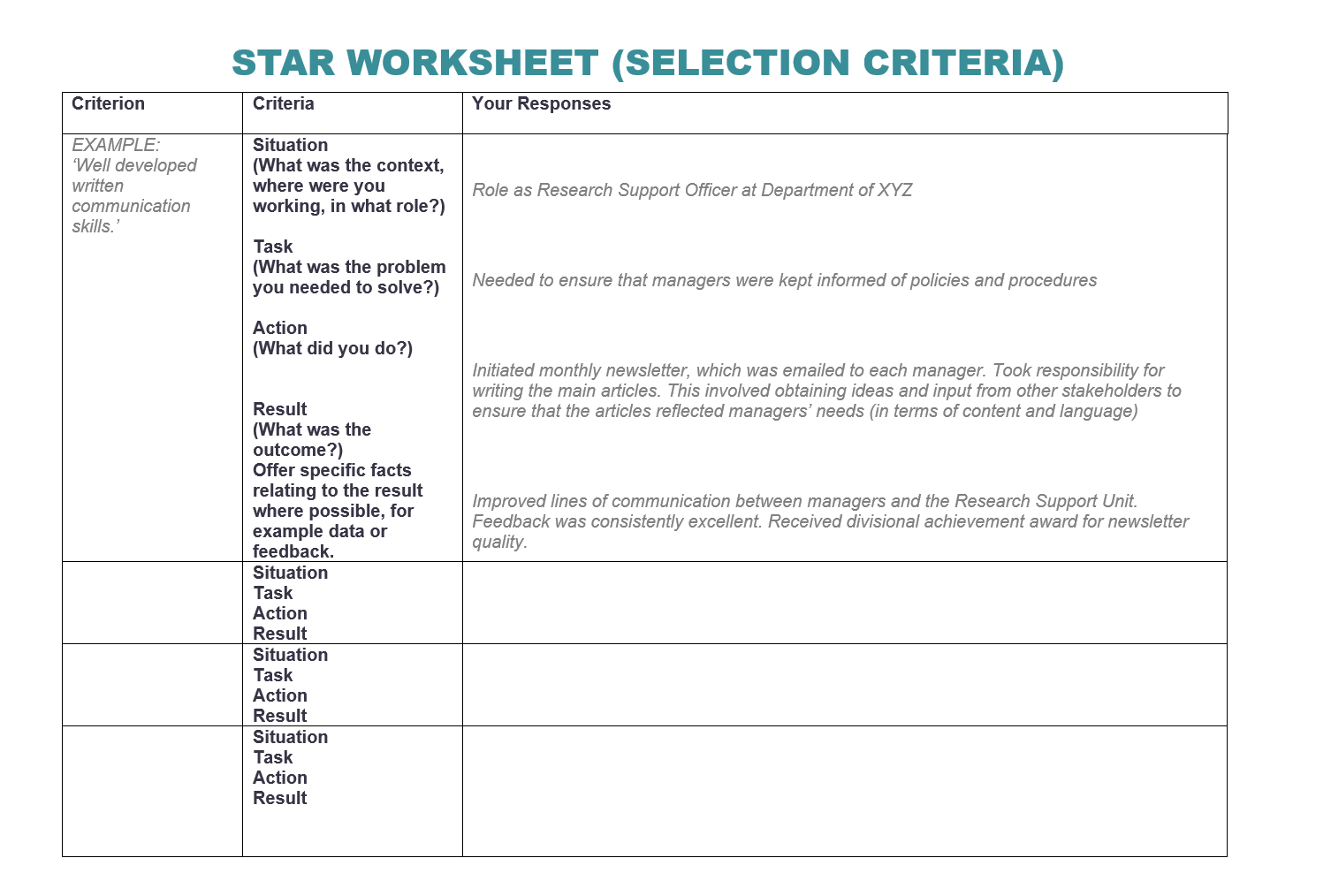You’re probably aware that the application process for government roles can be a bit more involved than in the private sector. One crucial aspect of applying for government positions is writing your selection criteria response.
Read on to learn our 10-step process for how to write selection criteria for government jobs, using the STAR (or CAR or SAO) method. We’ll also show you 9 selection criterion examples to inspire your own responses.
What Are Selection Criteria?
Selection criteria are the qualifications, skills, knowledge, attributes and experiences required for a particular government job. Not all roles require selection criteria responses, though most government applications do.
Usually, a panel will sit down and assess each candidate’s application; selection criteria offer a useful way to assess each candidates’ suitability for the role.
Essential and Desirable Selection Criteria
You’ll sometimes find a list of ‘Essential’ and ‘Desirable’ selection criteria. This means just what it says – if you can’t demonstrate the ‘Essential’ skills, you’ll be unlikely to get to interview.
The ‘Desirable’ selection criteria are things you should discuss if you have the relevant experience, but if you don’t, you still might be able to score an interview.
Selection Criteria Are Unique to Individual Jobs
When applying for a government job, you’ll typically encounter a list of selection criteria that must be addressed in your application.
These will be unique to the job you are applying for, so you will need to tailor your response for each job application (though, once you have a ‘bank’ of examples, this becomes much easier to do!).
A well-written selection criteria can make or break your chance of getting to interview, so it is vital you get this process right.
How Long Should Selection Criteria Responses Be?
Most government departments and agencies, both at the local, state and APS levels, typically specify how long they expect selection criteria responses to be in their job advertisements or application guidelines. These specifications are essential to ensure a standardised and fair evaluation process for all applicants.
If no guidance is given, we recommend each statement to be between 60 to 120 words.
Competency Frameworks
Many government departments have their own competency frameworks, which they mention should be addressed in their application guidelines. These frameworks set out the individual competencies, attributes or behaviours required at different levels within that organisation.
Examples include:
- APS Integrated Leadership System
- Leadership Competencies for QLD
- NSW Public Sector Capability Framework
- WA Public Sector Capability Profiles
- Victorian Public Service (VPS) Capability Framework
- Tasmanian State Service Senior Executive Leadership Capability Framework
How to Address Selection Criteria Requiring Competency Frameworks
You might find an application referring to a competency framework. Just as you do in a standard selection criteria response, you will need to address each of the bulletpoints or words reflected in the competency framework in these cases.
Should I Always Use the STAR Method?
One of the most effective ways to tackle selection criteria is by using the STAR method. STAR stands for Situation, Task, Action, and Result. It is a structured approach that helps you provide comprehensive responses that showcase your skills and experience.
It goes like this:
Situation: Describe the context or situation where you demonstrated the skill or attribute in question. E.g. What role were you in?
Task: Explain the specific task or challenge you faced in that situation.
Action: Detail the actions you took to address the task or challenge.
Result: Highlight the positive outcome or result of your actions.
There are other methods you may prefer to use, such as:
The SAO Method
SAO (Situation, Action, Outcome) or
The CAR Method
CAR (Challenge, Action, Result).
STAR is the most widely used format, and the one we recommend using, though all methods are acceptable.
How to Write Selection Criteria for Government Jobs in 10 Steps
Our tried-and-tested 10-step process provides a clear strategy for writing your own selection criteria application.
- Research the job – review the position description and organisation (including values).
- Confirm you have the required qualifications and experience needed for the job.
- Review the selection criteria and application guidelines, including length and formatting guidelines. Highlight keywords.
- Contact the contact officer if needed to clarify any points.
- Download our FREE STAR document worksheet for use in Microsoft Word.
- Copy and paste each of the selection criteria into our STAR document.
- Use our STAR document to brainstorm your responses.
- Copy and paste your answers to each criterion into a new Word document.
- Hone your responses, ensuring they read well and address the question.
- Proof-read your statements, ensuring they are error-free and meet length and formatting guidelines.
9 How to Write Selection Criteria for Government Jobs Examples
The following star selection criteria response examples will help you see this method in practice. Note, you should not include the bolded words i.e. Situation, Task, Action, Result in your final responses.
- Communication
Selection Criterion: “Demonstrate excellent written and verbal communication skills.”
STAR Response:
Situation: In my previous role as a Public Relations Specialist, I was tasked with creating and delivering presentations to clients and stakeholders. Task: My goal was to convey complex information in a clear and engaging manner. Action: I meticulously researched the subject matter, organised my content logically, and practiced my delivery. Result: As a result, my presentations consistently received positive feedback, and our client satisfaction ratings increased by 20%.
2) Teamwork
Selection Criterion: “Ability to work effectively in a team environment.”
STAR Response:
Situation: In my role as an Administration Officer during a government project, our team faced a tight deadline to submit a comprehensive report. Task: We needed to collaborate efficiently to meet the deadline and ensure the quality of our work. Action: I took the initiative to organise regular team meetings to coordinate our efforts, assigned specific tasks to team members based on their strengths, and fostered open communication. Result: Thanks to our collaborative efforts, we not only met the deadline but also received commendations from our supervisor for our teamwork and the quality of our report.
3) Problem-Solving
Selection Criterion: “Proven ability to solve complex problems.”
STAR Response:
Situation: In my role as a Data Analyst, I encountered a recurring issue of data discrepancies in our reports. Task: It was crucial to identify the root cause and implement a solution to prevent future errors. Action: I conducted a thorough analysis of our data sources, identified the inconsistencies, and collaborated with the IT department to streamline data collection processes. Result: Our data accuracy improved by 15%, and the issue of discrepancies was successfully resolved, resulting in more reliable reports.
4) Leadership
Selection Criterion: “Demonstrated leadership skills.”
STAR Response:
Situation: As a Project Manager, I was selected to lead a cross-functional team of 10 members on a critical project. Task: My responsibility was to provide guidance, set clear objectives, and ensure the team’s successful completion of the project. Action: I organised team meetings to define roles and responsibilities, actively communicated our progress to upper management, and provided support and motivation to team members. Result: The project was completed ahead of schedule, and my leadership was commended by both the team and senior management.
5) Selection Criterion: Analysis and Research
STAR Response:
Situation: In my previous role as a Market Analyst at XYZ Company, I was tasked with evaluating market trends to inform our product development strategy. Task: We needed to understand which product features would resonate most with our target demographic to stay ahead in a competitive market. Action: I conducted extensive market research, utilising various data analytics tools and surveys to gather consumer insights. I also analysed our competitors’ offerings and customer feedback to identify gaps in the market. Result: My research led to the identification of key trends, enabling our team to prioritise and develop features that directly addressed customer needs. This resulted in a 20% increase in customer satisfaction and a 15% growth in market share.
6) Selection Criterion: Accuracy and Attention to Detail
STAR Response:
Situation: While working as a Quality Control Specialist at ABC Manufacturing, I was responsible for ensuring the accuracy of product specifications and labeling. Task: Any inaccuracies in labeling could result in regulatory violations and damage the company’s reputation. Action: I implemented a rigorous review process, meticulously examining product labels, packaging, and specifications against regulatory requirements. I also trained team members to pay close attention to detail. Result: Thanks to these measures, we achieved a 99.9% accuracy rate in product labeling and specifications. There were no regulatory violations during my tenure, and the company’s reputation for quality and compliance was upheld.
7) Selection Criterion: Decision-Making
STAR Response:
Situation: As a Project Manager at DEF Solutions, I encountered a critical situation when a key team member unexpectedly resigned right before a major project deadline. Task: I needed to make swift decisions to ensure the project’s success without jeopardising team morale. Action: I immediately assessed the available options, including redistributing tasks, bringing in temporary support, and adjusting timelines. After careful consideration, I decided to hire a contract resource with relevant skills to bridge the gap. Result: The project was completed on time with the same level of quality, and team morale remained intact. My ability to make effective decisions under pressure ensured the project’s success.
8) Selection Criterion: Autonomy
STAR Response:
Situation: While working as a Research Scientist at a government research institution, Task: I needed to design and conduct experiments to test a new hypothesis independently. Action: I developed a comprehensive research plan, including experimental protocols and safety measures. I secured necessary resources, managed the project timeline, and conducted experiments meticulously. Result: My independent research led to groundbreaking findings that were published in a prestigious scientific journal. It also earned recognition from senior researchers and contributed significantly to the institution’s reputation in the field.
9) Selection Criterion: Knowledge/Experience of Specific Software or Equipment
STAR Response:
Situation: In my role as a Systems Engineer at TechGen Innovations, I was responsible for optimizing our network infrastructure. Task: I needed to leverage my knowledge of Cisco networking equipment to enhance network performance. Action: I applied my expertise in configuring and maintaining Cisco routers and switches, implementing advanced routing protocols, and troubleshooting network issues. I also stayed updated on the latest Cisco technologies and certifications. Result: By optimising our network infrastructure, we achieved a 30% increase in network speed and reliability. The company’s IT infrastructure became more robust, enabling seamless operations and cost savings.
Avoid These Common Mistakes When Writing Selection Criteria
- Avoid using vague examples. Be specific. Hint: if you can’t picture the exact situation/ day/ time in your mind, you’re being too vague.
- Don’t talk about what your team did, instead of what you did personally. Hint: Avoid the term “we” wherever possible.
- Avoid using a weak ‘Result’/ ‘Outcome’ statement. Always finish with what was achieved, and how you impacted this.
If you have been wondering how to write selection criteria for government jobs, we hope this guide has been helpful. You may wish to read more specific APS selection criteria examples, Queensland government cover letters and NSW government selection criteria examples.
Do you need further assistance with your selection criteria response? Our selection criteria writers can help. Learn more about our criteria writing process here or contact us for a quote.



